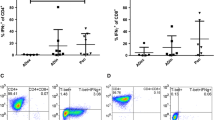Abstract
Although reduced cutaneous reactivities toCandida, albicans have been reported in patients with atopic dermatitis (AD), there is still controversy as to whether the in vivo lymphocyte proliferation response is normal or reduced. We have also reported that patients with AD manifest a decreased cutaneous response only toC. albicans antigen in scarification patch tests. The purpose of this study was to examine whether patients with AD show normal lymphocyte transformation responses toC. albicans antigen. Peripheral blood leucocytes (PBL) from 21 patients with AD and 14 healthy control (HC) subjects were cocultured with optimal concentrations ofC. albicans antigen and of superantigens (staphylococcal enterotoxin A and B). PBL from the patients with AD showed a significantly lower response toC. albicans antigen, but there was no statistically significant difference, in PBL responses to superantigens between the patients with AD and the HC subjects. This decreased proliferative response of PBL was particularly noticeable in those whose RAST scores forC. albicans antigen were high. These results suggest the development of a specific anergy toC. albicans antigen in patients with AD.
Similar content being viewed by others
References
Clark RAF (1989) Cell-mediated and IgE-mediated immune responses in atopic dermatitis. Arch Dermatol 125:413–416
Brown MAJ, Hanifin M (1990) Atopic dermatitis. Curr Opin Immunol 2: 531–534
Tanaka M, Aiba S, Matsumura N, Aoyama H, Tabata N, Sekita Y, Tagami H (1994) IgE-mediated hypersensitivity and contact sensitivity to multiple environmental allergens in adult patients with atopic dermatitis: complied results of RAST, prick and patch testing. Arch Dermatol 130: 1393–1401
Elliott ST, Hanifin JM (1979) Delayed cutaneous hypersensitivity and lymphocyte transformation. Arch Dermatol 115: 36–39
McGeady SJ, Buckley RH (1975) Depression of cell-mediated immunity in atopic eczema. J Allergy Clin Immunol 56:393–406
Hanifin JM, Rajka G (1980) Diagnostic features of atopic dermatitis. Acta Derm Venerol Suppl 92:44–47
Rajka G, Langeland T (1989) Grading of the severity of atopic dermatitis. Acta Derm Venerol Suppl 144:13–14
Pepys J (1975) Skin testing. Br J Hosp Med 14:412–417
Ito K, Nakagawa T, Morita Y, Okudaira H, Yamashita T (1989) Immunologic analysis of steroid-dependent asthma. Ann Allergy 62: 15–20
Frosch PJ, Kligman AM (1976) The chamber-scarification test for irritancy. Contact Dermatitis 2:314–324
Fisher AA (1986) The role of patch testing. In: Fisher AA (ed) Contact dermatitis. Lea & Febiger, Philadelphia, pp 9–29
Rawle FC, Mitchel, EB, Platts-Mills TAE (1984) T cell responses to the major allergen from the house dust mite Dermatophagoides pteronyssinus, antigen P1: comparison of patients with astma, atopic dermatitis, and perennial rhinitis. J Immunol 133:195–201
Tagami H, Urano-Suehisa S, Hatchome N (1985) Contact sensitivity to Candida albicans: comparative studies in man and animal (guinea-pig). Br J Dermatol 113:415–424
Jones HE, Reinhardt JH, Rinaldi MG (1974) Immunologic susceptibility to chronic dermatophytosis. Arch Dermatol 110: 213–220
Mosmann TR, Cherwinski H, Bond MW, Giedlin MA, Coffman RL (1986) Two types of murine helper T cell clone I. Definition according to profiles of lymphokine activities and secreted proteins. J Immunol 136:2348–2357
Stout RD, Bottomly K (1989) Antigen-specific activation of effector macrophages by IFN-γ(Th1) T cell clones. Failure of IL-4-producing (Th2) T cell clones to activate effector function in macrophages. J Immunol 142:760–765
Fiorentino DF, Bond MW, Mosmann TR (1989) Two types of mouse T helper cell IV. Th2 clones secrete a factor that inhibits cytokine production by Th1 clones. J Exp Med 170:2081–2095
Boom WH, Liano D, Abbas AK (1988) Heterogeneity, of helper/inducer T lymphocytes II. Effects of interleukin 4-and Interleukin-2-producing T cell clones on resting B lymphocytes. J Exp Med 167:1350–1363
Killar L, MacDonald G, West J, Woods, A, Bottomly K (1987) Cloned, I-a restricted T cells that do not produce interleukin 4 (IL-4)/B cell stimulatory factor 1 (BSF-1) fail to help antigen-specific B cells. J Immunol 138:1674–1679
Wierenga EA, Snoek M, Groot C de, Chretien I, Bos JD, Jansen HM, Kapsenberg ML (1990) Evidence for compartmentallization of functional subsets of CD4+ T lymphocytes in atopic dermatitis. J Immunol 144:4651–4656
Koivikko A, Kalimo K, Nieminen E, Viander M (1988) Relationship of immediate and delayed hypersensitivity to nasopharyngeal and intestinal growth of Candida albicans in allergic subjects. Allergy 43:201–205
Savolainen J, Koivikko A, Kalimo K, Nieminen E, Viander M (1990) IgE, IgA and IgG antibodies and delayed skin response towards Candida albicans antigens in atopics with and without saprophytic growth. Clin Exp Allergy 20:549–554
Salvolainen J Lammintausta K, Kalimo K, Viander M (1993) Candida albicans and atopic dermatitis. Clin Exp Allergy 23: 332–339
Buslau M, Menzel I, Holzman H (1990) Fungal flora of human faeces in psoriasis and atopic, dermatitis. Mycoses 33 (2): 90–94
Picker, LJ, Treer JR, Ferguson-Darnell B, Collins PA, Buck D, Terstappen LWMM (1993) Control of lymphocyte recirculation in man 1. Differential regulation of the peripheral lymph node homing receptor L-section in T cells during the virgin to memory cell transition. J Immunol 150: 1105–1136
Picker LJ, Kishimoto TK, Smith CW, Warnock RA, Butcher EC (1991) ELAM-1 is an adhesion molecule for skin-homing T cells. Nature 349:796–799
Rossiter H, Reijsen F von, Mudde GC, Kalthoff F, Brujnzeel-Koomen CAFM, Picker LJ, Kupper TS (1994) Skin disease-related T cells bind to endothelial selections: expression of cutaneous lymphocyte antigen (CLA) predicts E-selectin but not P-selectin binding. Eur J Immunol 24:205–210
Babi LFS, Picker LJ, Soler MTP, Drzimalla K, Flohr P, Blaser K, Hauser C (1995) Circulating allergen-reactive T cells from patients with atopic dermatitis and allergic contact dermatitis express the skin-selective homing receptor, the cutaneous lymphocyte-associated antigen. J Invest Dermatol 181:1935–1940
Author information
Authors and Affiliations
Rights and permissions
About this article
Cite this article
Tanaka, M., Aiba, S., Takahashi, K. et al. Reduced proliferative responses of peripheral blood mononuclear cells specifically toCandida albicans antigen in patients with atopic dermatitis — comparison with their normal reactivity to bacterial superantigens. Arch Dermatol Res 288, 495–499 (1996). https://doi.org/10.1007/BF02505243
Received:
Issue Date:
DOI: https://doi.org/10.1007/BF02505243




